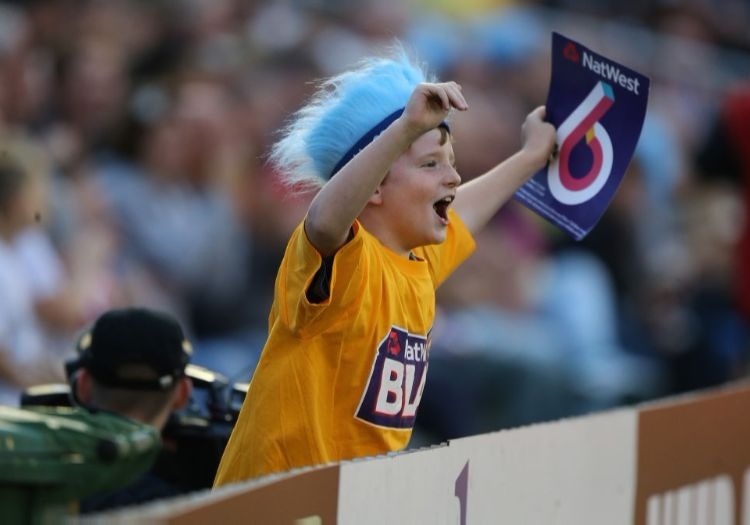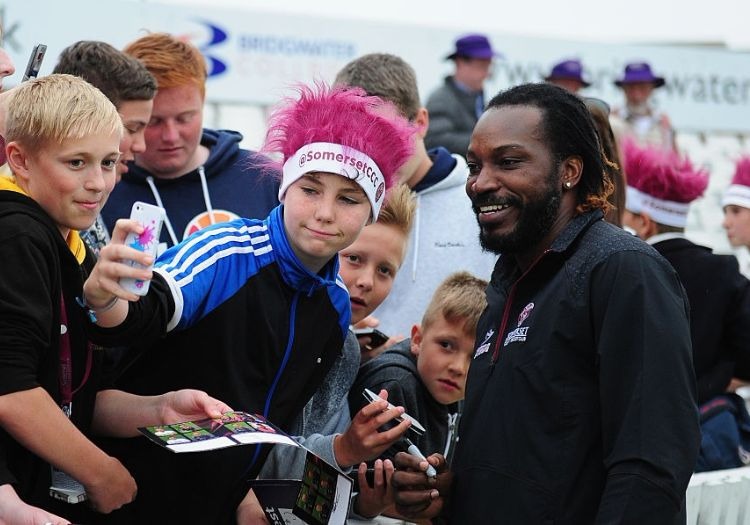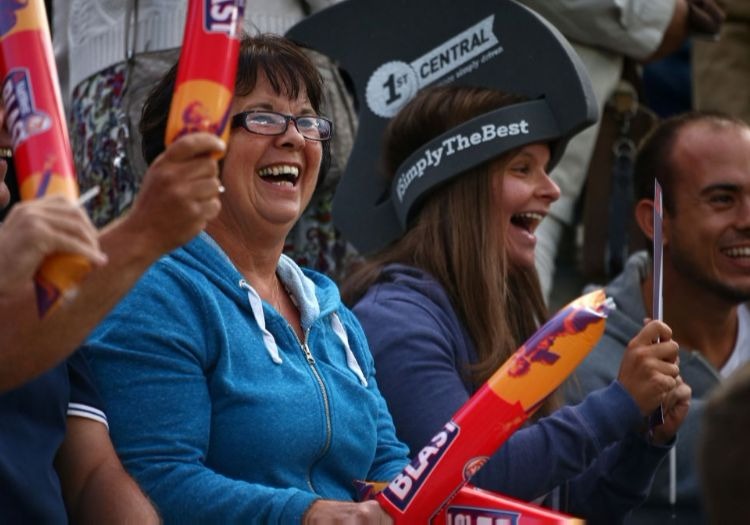Who needs rivalry and history to attract young families, anyway? Kids will respond just as well to high-octane, thrill-a-minute entertainment, pyrotechnics as high as your house and an outfield swathed in kits from every corner of the rainbow

The ECB want young fans to flock to their T20 competition
What’s in a name? When it comes to sport, the answer is “quite a lot”.
As such, it came as something of a surprise when it emerged this month that the ECB will not give any of the eight teams in its new T20 competition a title incorporating the cities, counties or venues where they will be based.
“Keeping geography out,” reported Elizabeth Ammon in The Times, “makes it easier to move teams around for their matches.
“It also allows for the introduction of new branding and a fan base not influenced by location.”
Which begs the question: By what will the fan base actually be influenced?
Historically, and across a wide range of sports, clubs have been easily defined by their geographical boundaries.
Whether it’s Real Madrid, New York Yankees, Stade Français, Dallas Cowboys or Chennai Super Kings, sport has always played to the tribalism of supporters; the notion that “my team is better than yours”, with particular emphasis on the word “my”.
Over many decades, sports teams of all shapes and sizes have successfully harnessed the emotions of supporters and created a bridge between their commercial brand and the customers who think of themselves as something more.
As Eric Simons, the author of The Secret Lives of Sports Fans, wrote: “A sports team is an expression of a fan’s sense of self … an expansion of a fan’s sense of self. It is not an obnoxious affectation when a devotee uses the word ‘we’; it’s a literal confusion in the brain about what is ‘me’ and what is ‘the team’.
“In all kinds of unconscious ways, a fan mirrors the feelings, actions and even hormones of the players. Self-esteem rides on the outcome of the game.”
Yet it appears the ECB is not too fussed about that traditional relationship when it comes to their new T20 competition, and county members may well end up feeling disenfranchised and disenchanted as a result.
It’s hardly a secret that the old guard are not the target market here. Instead, the focus has switched to the uninitiated; the boys and girls who will go to their first game thinking the googly is named after a search engine, and DRS is when you go to get a jab and a lollipop.
Who needs rivalry and history to attract young families, anyway? Kids will respond just as well to high-octane, thrill-a-minute entertainment, pyrotechnics as high as your house and an outfield swathed in kits from every corner of the rainbow.
And why bother with the complications of fan psychology when you can fill a ground with more stimulants than WADA’s banned list?
Besides, if it doesn’t work at first the game’s bigwigs can always ramp up the marketing budget or subsidise large chunks of the entry price from the colossal warchest generated by ECB chief executive Tom Harrison’s latest, gluttonous broadcasting rights auction.
To steal from Kevin Costner’s subconscious, “build it and they will come”.

It’s hardly a secret that the old guard are not the target market here
So how difficult will it actually be to conjure eight teams out of the ether? Very, you would imagine.
While clubs’ reach has expanded considerably in the digital age, most rose from modest beginnings – local teams for local people. And the majority carried the name of their town or borough with them.
There are exceptions. Premier League Arsenal, for example, or Port Vale, the League Two club which is named after the house it was formed in.
But you’d be hard-pressed to find a Valiants fan whose family did not have historical links to the Burslem suburb where their team’s stadium is based. And while Arsenal are now an international brand, they were founded in 1886 by workers at a munitions factory in Woolwich.
Rugby’s Aviva Premiership features Harlequins and Saracens – sides with no discernable place name in their titles but who both have longstanding associations with parts of the capital.
In southern hemisphere Super Rugby, the Bulls play the Crusaders and the Chiefs take on the Highlanders but each have very obvious ties to the provincial clubs of old.
The ECB might point to the relative success of the outfit-formerly-known-as London Wasps, who moved to Coventry’s Ricoh Arena, dropped the ‘London’ prefix, regularly draw in excess of 20,000 fans and posted the third highest attendance aggregate in the competition (234,360) in 2016/17.
But Wasps were not dreamed up upon relocation in 2014. The club was formed in 1867 and, during the professional era, won six English titles and two European crowns. They were already a presence in the sporting sphere.
Presuming they forfeit the use of city and county names, none of the ECB’s eight new sides for their showpiece tournament will have that kind of history or heritage to fall back on.

The eight teams’ most potent marketing tools will be their star players
Instead, the competition in its base form – before the marketers and public relations gurus, kit manufacturers and entertainment experts get involved – will look like a row of new-build houses or a shelf stacked with flat-pack furniture. Identicricket, if you will.
It’s up to the organisers to create eight unique brands, each of which entices a fresh audience of cricketing converts and, more importantly, keeps them coming back.
To do so from scratch, in an environment that already boasts established teams with established supporter groups and, furthermore, an established T20 competition among the counties, will not be a simple task.
How, for instance, will the men and women running the tournament form associations between fans and teams for just 10 weeks?
Will their websites remain fully functional across 12 months? Can social media accounts really provide engaging content the whole year round while their team’s players are involved in the County Championship, Royal London One-Day Cup and NatWest T20 Blast?
Substantial advertising revenue is being earmarked for the project – as much as hundreds of thousands of pounds for each day of the tournament, it has been said – and the ECB will work closely with marketing consultants to conjure up as colourful a competition as possible, but the task at hand remains a daunting one. That’s not to say it’s impossible.
Of all sports, cricket has shown the most success in imagining new brands and promoting them to the masses.
The Indian Premier League and the Big Bash have enjoyed tremendous attendances and viewing figures on TV, while T20 tournaments in the Caribbean, Bangladesh, Pakistan and South Africa have also shown that you needn’t have history to have impact and reach in your community.
But again, herein lies the rub. Brisbane Heat, Royal Challengers Bangalore, even Comilla Victorians of Bangladesh at least have formal links to specific regions and, as such, their target community is much more easily defined.

Of all sports, cricket has shown the most success in imagining new brands and promoting them to the masses
One way, without any mention of cities or counties, that the ECB can give its eight teams some form of identity is via the use of regional themes.
It’s almost inevitable, for instance, that the Cardiff-based franchise will play in red. It would not be a surprise, either, if it is ‘The Dragons’ who play their games in south Wales.
The use of the red and white roses for the sides based at Old Trafford and Headingley would make sense, as would the green of Robin Hood at Trent Bridge. Could Edgbaston be the stage for ‘The Bards’? I digress.
The eight teams’ most potent marketing tools will be their star players.
In a modern sporting world connected along superfast fibre optics and by 24-hour rolling news channels, hyper-local fandom does not apply as much to millennials or members of Generation Z as it did to baby-boomers or those in Generation X.
Indeed, there appears to be a growing trend of fans becoming as much if not more attached to individual players than they are to teams, perhaps an offshoot of the ever-expanding sphere of social media, where celebrities are so much more accessible than ever before.
For many, it didn’t matter if Kevin Pietersen has been playing for Melbourne Stars, Deccan Chargers, St Lucia Zouks, Quetta Gladiators or Dolphins. What mattered was that he was playing.
In a 2001 paper for the Journal of Applied Psychology, Nicholas Dixon split sports fans into two distinct groups – the ‘partisan’ and the ‘purist’.
The partisan, Dixon says, “is a loyal supporter of a team to which she may have a personal connection or which she may have grown to support by dint of mere familiarity”.
The purist, meanwhile, “supports the team that he thinks exemplifies the highest virtues of the game, but his allegiance is flexible”.
While a simple 50-50 divide has been made more complex by heightened levels of technology in the 17 years since his thesis was published, Dixon’s analysis largely illustrates the two sections of support, or potential support, that the ECB have chosen to pick between.
The type of fan the governing body is chasing for its new competition is similar to Dixon’s ‘purist’... only swapping “exemplifies the highest virtues of the game” for “has the players he or she most enjoyed watching in the IPL/Big Bash”.
That target market very deliberately dilutes the partisanship in English cricket. It’s bold, it’s brave and it is most definitely a gamble.
Is it for the good of the game? We will have to wait and see.